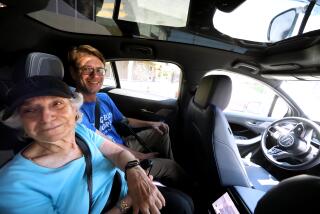Endless apps, eco-friendliness and a music-creation tool
The giant Consumer Electronics Show in Las Vegas wrapped up its second day Friday with few big-time announcements. So it became a day for the Los Angeles Times technology staff to explore and blog about technologies that didn’t have their own press conference. Here is a sampling:
Sony Dash
The stampede toward 3-D may be the headline of this year’s CES, but announcements about apps have provided a seemingly relentless drumbeat. Apps on TV, apps in cars, apps in your pocket.
Anyway, my choice as the show’s official apps mascot would be Sony’s Dash Personal Internet Viewer, a wedge-shaped box with a 7-inch touch screen that runs, well, apps.
Sony promises thousands of these free software widgets, including some that are utilitarian (an alarm clock, an e-mail reader), some devoted to entertainment (video streams and games) and some that are just silly (a looped video of a dog licking the screen from the inside).
Calling it a “personal Internet viewer” is a little misleading because the Dash isn’t suited for general Web browsing. Its apps can deliver many of the quotidian resources of the Internet, though, providing such vitals as news, traffic information, recipes and updates from your EBay watch list.
At $200, the Dash seems a little pricey. It’s barely cheaper than a netbook and it offers little of a netbook’s power. But it does include wireless networking and free access to Sony’s Bravia Internet Video streaming platform, which supplies YouTube, Pandora personalized online radio, Blip.tv and Crackle’s mix of online originals and videos from the Sony Pictures vault. So it has that working for it.
For those who like having key Web resources available at the touch of a button but don’t want to keep a computer running 24/7, the Dash may be the solution. Hey, even Facebook addicts don’t need a computer in every room.
-- Jon Healey
Green tech
For years, the technology industry has been “going green.” At this year’s show, it seemed many businesses finally got there.
“Green” is no longer a buzz word, according to analysts who keep up with these kinds of things. A potential driving force could have to do with manufacturers’ having discovered business advantages of Earth-friendly products -- ones that don’t rely on charging consumers more to go green.
In many booths, advertising for eco-friendliness ran alongside the newest products. Samsung had a visual detailing the PET recycling process, which uses water bottles to make the plastic in television sets and cellphones.
The big players also have a strategic reason to invest in the low-power, high-performance thin-film transistors that power newer LCD TVs. Thanks to advancements last year by Mitsubishi, those TFTs could be used to build solar-powering units.
“If LCD tanks, they could always go into solar cells,” said Steve Sechrist, an analyst for Insight Media.
-- Mark Milian
Music Mastermind
CES isn’t usually a place for mulling over existential questions, but here are a couple for you: What constitutes a musical instrument, and what does it mean to be a musician?
I couldn’t help wondering about that after seeing a demo of a prototype from Music Mastermind, a 2-year-old Calabasas start-up founded by a former major-label executive and a Wall Street trader.
Music Mastermind is developing a music-creation tool that combines video games and composition. It enables people to create full-blown, professional-sounding songs by singing into a computer or specialized portable device, then using a software band to provide the backing track. And it does so with the look and feel of a video game.
Co-founder Matt Serletic, former chief executive of EMI’s Virgin label and current owner of Emblem Music Group, said the software was designed to give amateurs a way to translate the melodies in their heads into songs they could share.
But by creating a community around the game, it enables would-be professionals to use the software to audition their material and build an audience for it. It also gives established professional recording artists a new way to interact with fans -- for example, by putting the vocals and instrument tracks for a song into the game and inviting fans to add their mark.
Although the software is still being developed, Music Mastermind provided a sample at a private party in Las Vegas on Thursday evening. Serletic brought in a ringer -- Angie Aparo, a professional singer-songwriter -- to use the program’s virtual recording studio, which was staffed by rock-garbed avatars on vocals, drums and bass.
As Aparo sang a brief melody into a microphone wired to the laptop through a small mixing board, the program recorded it and tweaked the pitch to bring it into tune. (Aparo didn’t need it, but one can imagine how important that feature would be for some users.) He then mimicked the sounds of a bass drum, snare and cymbals to trigger and record sounds from a synthesized kit, which the program turned into a drum loop.
To fill out the song, Aparo chose a virtual bass and acoustic guitar, whose tracks were generated automatically by the software. (Users can change notes and chords as desired by adjusting some on-screen controls.) He was about to overdub some backing vocals when the demo gremlins attacked, sending the session into hiatus.
Despite the technical problems, the results were impressively polished, even hi-fi. It’s obviously not the same as playing the notes yourself on real instruments with honest-to-goodness recording equipment, but it’s close enough to be startling.
The price and release date of the Music Mastermind software and its hand-held version are still to be determined.
-- Jon Healey






